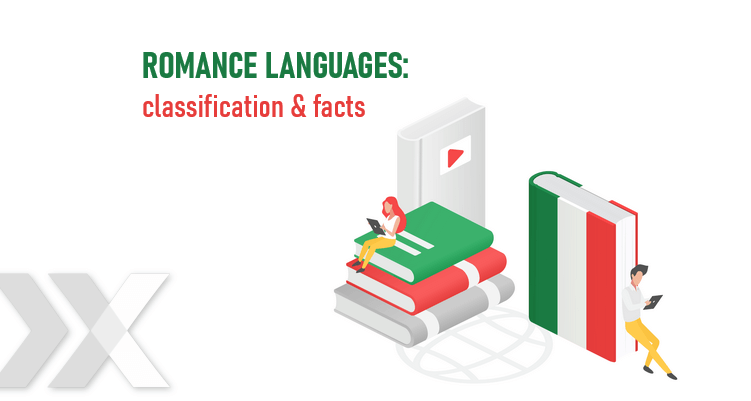Romance Languages: Characteristics and Categorisation
Dominik Parajka 13.12.2022 Meet the World with Lexika Reading time: 3 min.
13.12.2022 Meet the World with Lexika Reading time: 3 min. 
Romance languages are widely regarded as the most romantic languages in the world. They belong to the Indo-European language family together with Germanic, Slavic, Baltic languages, and are spoken by over 800 million people worldwide. What interesting facts lie beneath their surface?
The Origin of Romance Languages
Romance languages evolved from Vulgar Latin spoken in the Roman Empire. This now dead language then spread to the far corners of Europe and, during the colonial era, even America and Africa. Its swift expansion birthed different dialects that formed the basis for individual Romance languages. Experts estimate that these began splitting from Vulgar Latin between the 3rd and 9th centuries.
Fun Fact: Even though Romance languages evolved from Latin, Latin itself doesn’t belong in the branch. Rather, it belongs to the Italic languages spoken in antiquity.
Geographical Occurrence of Romance Languages
Romance languages are most commonly spoken in Southern and Southwestern Europe. They’re also significant in Romania and Latin America, having been introduced during colonisation.
Each Romance language’s evolution has been influenced mostly by surrounding countries. For example, approximately 66% of Romanian vocabulary derives from Latin. However, since Romania neighbours countries with Slavic languages, approximately 20% of its vocabulary come from these.
The Classification of Romance Languages
Categorising Romance languages remains a head-scratcher for linguists. Although the big ones are easily identifiable, it can be difficult to determine if the smaller ones are languages or just dialects. However, noticeable similarities exist between them. The languages of neighbouring countries share the most common features, and the growing distance also grows the differences.
Linguists assume that currently roughly 32 Romance languages exist. These are commonly divided into the following sub-branches.
Italo-Dalmatian
This sub-branch contains Italian, Sard, Neapolitan, Dalmatian, Corsican and Tuscan.
Ibero-Romance
Here we can find Portuguese and Spanish, as well as Catalan, Galician, Asturleonese and Mirandese.
Gallo-Romance
The main representative of this branch is French, along with Franco-Provençal, Occitan, Provençal and Walloon.
Rhaeto-Romance
These are occasionally considered a part of Gallo-Romance languages, as they share many common features. Rhaeto-Romance languages include Romansh, Friulian and Ladin.
Eastern Romance
These comprise Romanian, Moldovan, Aromanian, Istro-Romanian, Dalmation and Istriot.
Did you know that there is a special category of Romance languages called African Romance languages. They are seldom studied and resulted from European colonisation.
The Most Significant Romance Languages and Interesting Facts about Them
Romance languages are the most widely spoken in the world. Among them, these are the most popular ones.
Spanish
Spanish is the second-most widely spoken language worldwide – used by over 500 million people. Not only is it spoken in Spain, but also on the American continent.
Do you know why Spanish uses the inverted question mark(¿)? It makes it easier to read the written text. Furthermore, it’s used to indicate whether the following sentence is interrogative or indicative. If the question forms part of a longer sentence, then the inverted question mark is placed before the first word of the clause asking the question (and not at the beginning of the sentence itself). For example: “José, ¿adónde vas?” (Where are you going, José?).
Portuguese
Portuguese is the first language for over 210 million people.
Interestingly enough, out of all Portuguese speakers, the smallest number live in Portugal. There are far more in Brazil and Mozambique.
Italian
Italian is different from most contemporary Romance languages because of its so-called double constants. It’s also the closest to its ancestral language – Latin. They share more grammatical similarities than any other Romance language, and Italian includes the most Latin words.
French
Many consider French the most romantic language in the world. But if you’re only just starting to learn French, and need to manage its complicated pronunciation, countless exceptions and both the decimal and vigesimal (number 20-based) systems in counting, a few not-so-romantic words might pop into your head.
Romanian
Romanian is the official language in Romania and Moldova. Unlike the rest of the languages mentioned above, which place the definite article at front of the word, the definite article in Romanian is attached to the end. For example: bărbat (man) – bărbatul (the man, masculine), femeie (woman) – femeia (the woman, feminine).
Do you speak any Romance languages? Which one do you like the most?

I started working as a copywriter at Lexika in 2021. However, online marketing, blogging and writing texts have been my domain for over five years. I love foreign languages and mostly work with English. I learned to like it when I was a kid because I used to live in England during elementary school for almost a year. I enjoy diving deep into foreign nationalities and cultures.
Share it!